AMD’s 5 GHz Turbo CPU in Retail: The FX-9590 and ASRock 990FX Extreme9 Review
by Ian Cutress on August 9, 2014 8:00 AM ESTCPU Benchmarks: Comparing Motherboards
Readers of our motherboard review section will have noted the trend in modern motherboards to implement a form of MultiCore Enhancement / Acceleration / Turbo (read our report here) on their motherboards. This does several things – better benchmark results at stock settings (not entirely needed if overclocking is an end-user goal), at the expense of heat and temperature, but also gives in essence an automatic overclock which may be against what the user wants. Our testing methodology is ‘out-of-the-box’, with the latest public BIOS installed and XMP enabled, and thus subject to the whims of this feature. It is ultimately up to the motherboard manufacturer to take this risk – and manufacturers taking risks in the setup is something they do on every product (think C-state settings, USB priority, DPC Latency / monitoring priority, memory subtimings at JEDEC). Processor speed change is part of that risk which is clearly visible, and ultimately if no overclocking is planned, some motherboards will affect how fast that shiny new processor goes and can be an important factor in the purchase.
Point Calculations – 3D Movement Algorithm Test: link
3DPM is a self-penned benchmark, taking basic 3D movement algorithms used in Brownian Motion simulations and testing them for speed. High floating point performance, MHz and IPC wins in the single thread version, whereas the multithread version has to handle the threads and loves more cores.
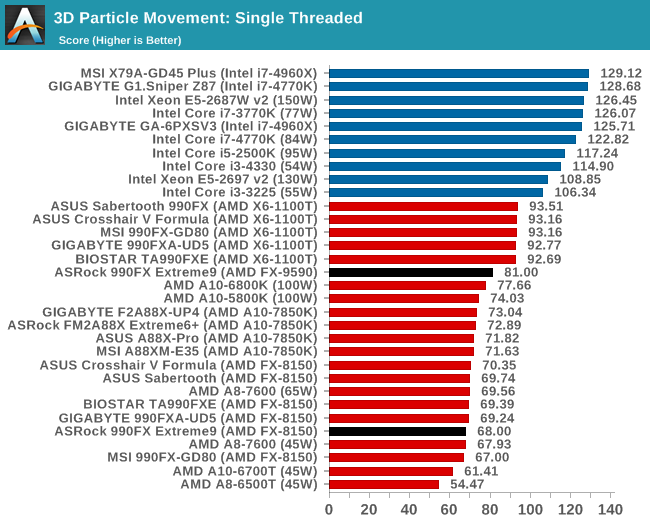

Compression – WinRAR 5.0.1: link
Our WinRAR test from 2013 is updated to the latest version of WinRAR at the start of 2014. We compress a set of 2867 files across 320 folders totaling 1.52 GB in size – 95% of these files are small typical website files, and the rest (90% of the size) are small 30 second 720p videos.
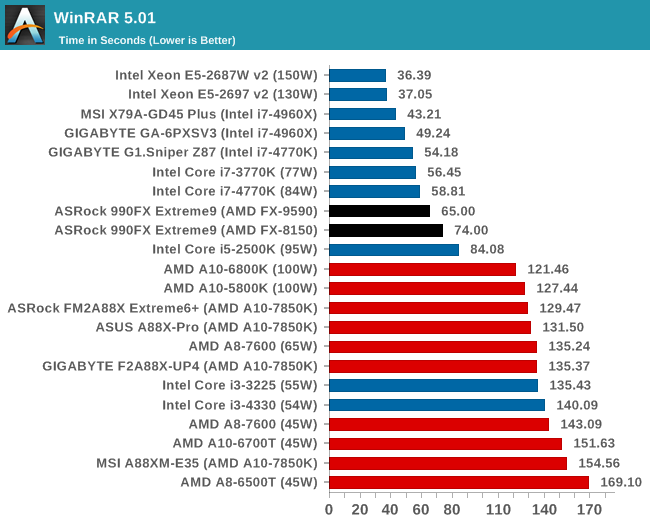
Image Manipulation – FastStone Image Viewer 4.9: link
FastStone is the program I use to perform quick or bulk actions on images, such as resizing, adjusting for color and cropping. In our test we take a series of 170 images in various sizes and formats and convert them all into 640x480 .gif files, maintaining the aspect ratio. FastStone does not use multithreading for this test, and results are given in seconds.
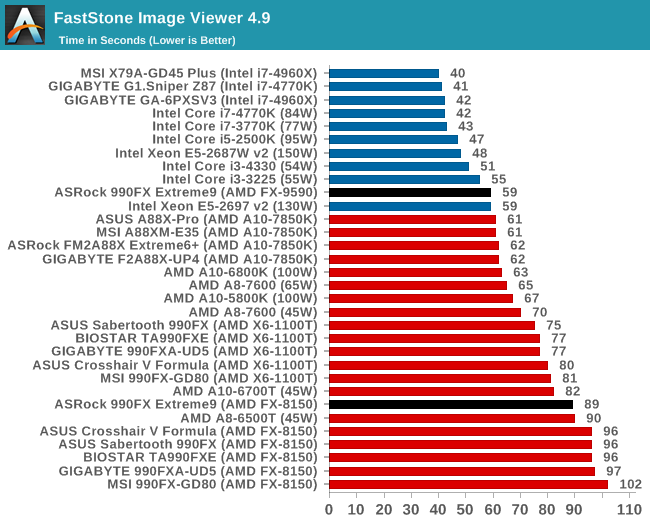
The FX-8150 result for the Extreme9 compared to other motherboards shows one of two things - the latest Windows SP1 with core parking updates has an effect, or the BIOS is more efficient at handling turbo modes than our older reviews.
Video Conversion – Handbrake v0.9.9: link
For HandBrake, we take two videos (a 2h20 640x266 DVD rip and a 10min double UHD 3840x4320 animation short) and convert them to x264 format in an MP4 container. Results are given in terms of the frames per second processed, and HandBrake uses as many threads as possible.
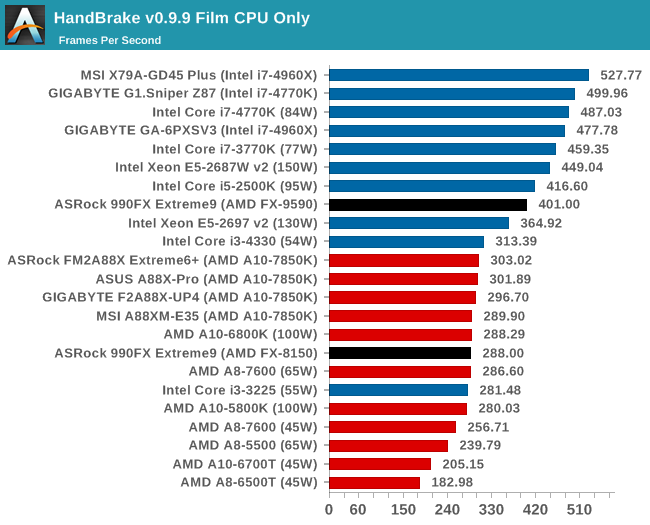

Rendering – PovRay 3.7: link
The Persistence of Vision RayTracer, or PovRay, is a freeware package for as the name suggests, ray tracing. It is a pure renderer, rather than modeling software, but the latest beta version contains a handy benchmark for stressing all processing threads on a platform. We have been using this test in motherboard reviews to test memory stability at various CPU speeds to good effect – if it passes the test, the IMC in the CPU is stable for a given CPU speed. As a CPU test, it runs for approximately 2-3 minutes on high end platforms.
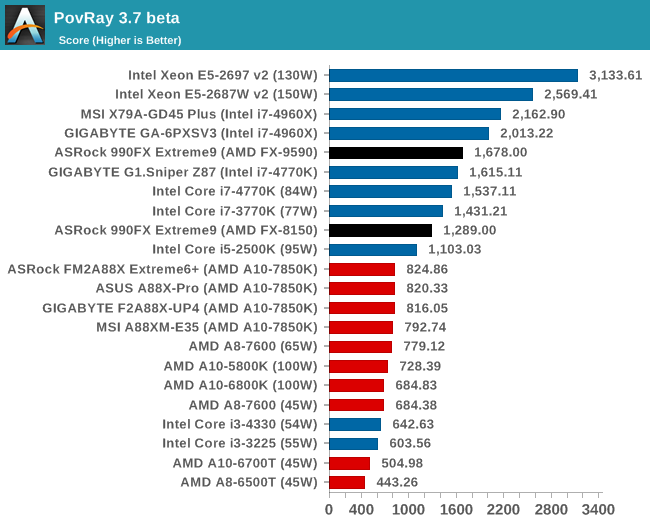
Synthetic – 7-Zip 9.2: link
As an open source compression tool, 7-Zip is a popular tool for making sets of files easier to handle and transfer. The software offers up its own benchmark, to which we report the result.
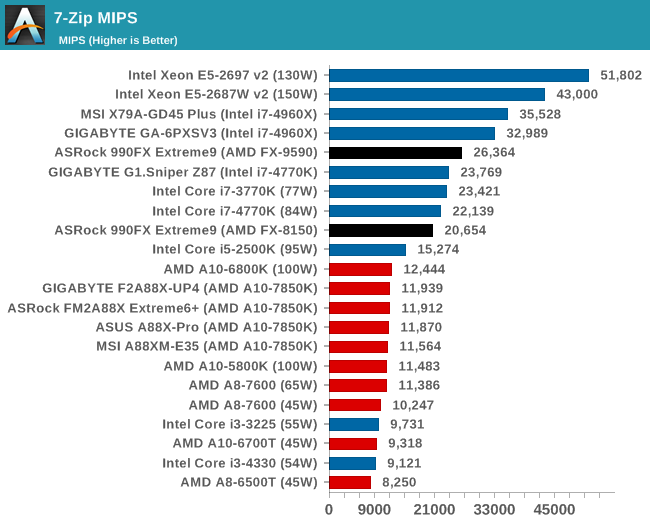










146 Comments
View All Comments
BMAN61 - Sunday, August 10, 2014 - link
" Alongside testing this CPU, the 220W TDP requires a substantial motherboard to match. Due to the age of the platform, the AM3+ socket and the old 990FX chipset, finding a motherboard can be rather tricky. Many of the AM3+ motherboards that were launched were only suited for the FX-8350 processors, which had a 125W TDP. This is yet another reason that AMD wanted the FX-9590 in the hands of system builders who would chose high end motherboards that could cope.Two of the newest motherboards to be released for 990FX were the ASRock 990FX Killer and the ASRock 990FX Extreme9. We reported the release of the Killer in December 2013, but the Killer is unsuitable here as the specification sheet lists processors up to 125W only. The Extreme9 is ASRock’s high-end AM3+ motherboard, and more suited to the task. "
This statement isn't entirely true; the ASUS Sabertooth 990FX motherboard supports this 220 watt CPU http://www.asus.com/ca-en/Motherboards/SABERTOOTH_... the only requirement is a BIOS update and better cooling.
StrangerGuy - Sunday, August 10, 2014 - link
So ~$170 solely for a mobo to reliably run a AMD chip.Intel is laughing to death somewhere a 4790K can be dropped into the cheapest of S1150 mobos and it just simply works.
just4U - Sunday, August 10, 2014 - link
Off the top of my head I don't know of anyone who has purchased a $350 i7 and paired it up with a $65 motherboard.. Most won't even use the stock cooler since +80c temperatures under load is a little on the alarming side.. Those that tend to purchase it as part of a new system are usually looking at $170 Motherboards and $30+ coolers.StrangerGuy - Sunday, August 10, 2014 - link
Intel temperature issues != AMD power delivery issues. The former can simply be solved with a $30 HSF, while the latter needs a $170 mobo AND even stronger cooling.And I'm one of those guys who run a 4790K on a $60 budget mobo. Paying an extra $100 for CPU at 4GHz stock with even higher turbo and HT is certainly more value for money than a $240 4690K with a $160 mobo with extravenous features that I don't need, and this does not include extra costs for cooling a OCed chip plus dealing with chip lottery. I don't know why is that even surprising to some...
just4U - Monday, August 11, 2014 - link
I don't believe you have a $60 board paired up with your 4790K. Sorry S... it simply doesn't make sense. You may not have Z97 deluxe but I think it's doubtful you've paired it with a H81 either.. That's like going out and buying a 780Ti and then using the worst turd of a PSU to power the damn thing.. or saying yeah this Celeron should be enough for that.. lol.. no.designgears - Sunday, August 10, 2014 - link
*facepalm*How many time did a stock i5 just beat an 8 core OC chip?!
mapesdhs - Tuesday, August 12, 2014 - link
A point which way too many AMD fans simply choose to ignore. Ah the 1st Rulestrikes again...
Ian.
nenforcer - Sunday, August 10, 2014 - link
The Realmark Audio Analyzer results have labeled this motherboard as having the Realtek ALC1150 audio codec just like most other modern motherboards, however, as stated previously in the article this motherboard has the older Realtek ALC898 codec.Jedibeeftrix - Sunday, August 10, 2014 - link
"If AMD is to return to the performance market, the power consumption has to be comparable to Intel, or if it is slightly higher, the chipset has to offer something Intel cannot. Any suggestions for what that feature should be should be submitted on a postcard/in the comments."24 PCIe 3.0 lanes on-die for uncompromised graphics whilst allowing M.2/Express at 3.0 4x:
http://jedibeeftrix.wordpress.com/2014/07/25/amd-t...
silverblue - Sunday, August 10, 2014 - link
Kaveri, from a technological standpoint, is a refined version of Zambezi, but it's still not perfect; they fixed an AVX bug but hamstrung FP adds somehow. Work done per module is improved due to the decoder changes.We don't know how L3 cache would help performance, as this is the first edition of the architecture that doesn't have such a flavour. The other issue is the reduced clock speed thanks to the 28nm SHP node; while it's very possible that a 4M/8T setup would exceed the 8350's performance, how much power would it use for that? I would theorise such a CPU (note - same clocks as the 7850K, and without L3 cache) outperforming the 8350 by about 10-15% in MT workloads, matching it in ST and even falling behind by 10-15% in FP; perhaps that's another reason for the lack of an FX line given that it'd be a regression. Right now, I don't think it'd serve in AMD's best interests to release a new FX series as it wouldn't benefit consumers at all.
I should imagine that if Excavator brings the rumoured IPC gains, AMD would simply dump AM3+ and resurrect FX as a 2M/4T FM2+ part; in essence, an i5 competitor. They did say that improved IPC was Excavator's raison d'etre; considering MT is fixed, it should mean instructions per core. Get the IPC high enough and they won't NEED to clock the parts so high, thus lower power; on this point, Carrizo is supposed to be rated at 65W TDP.